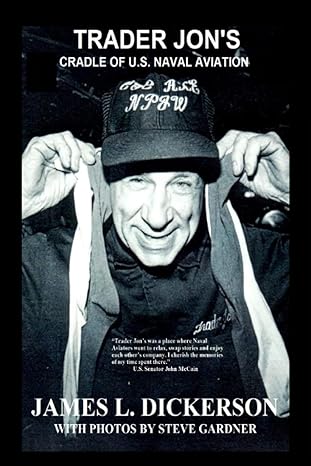
Trader Jon's: Cradle of U.S. Naval Aviation
For nearly five decades, Trader Jon's was where the men who trained to fly the monster jets of the U.S. Navy let down their hair before going off to fight-and sometimes die-in lonely battles above obscure patches of water and land over Korea, Vietnam, and Bosnia. One measure of the Navy's deep regard for Weismann is the singular honor afforded him by the naval air station in Pensacola, Florida, of naming a runway after him-TRADR-ONE.This is a biography of Martin Weismann, owner of the legendary Pensacola, Florida bar, Trader Jon’s, a second home to thousands of naval aviators, sailors, astronauts, movie stars, and journalists. The book also includes an encounter with Lt. Colonel Sarah Deal, the first female pilot to fly for the U.S. Marine Corps. She was in Pensacola to undergo training at the Naval Air Station.It was where America’s astronauts contemplated their future as they gazed at the time-worn artifacts of the past. Alan Shepard the first American in space and John Glenn the third American to travel in space were frequent visitors to the bar. It was where the famed Blue Angels, the U.S. Navy’s precision flying team, met each year to induct new members into their ranks. Also among the celebrity Navy pilots who trained in Pensacola was late U.S. Senator John McCain, who was a regular at the bar during his training.It was where nearly every major symbol of the American Dream, including Nobel Prize-winning author Ernest Hemmingway, Pulitzer Prize-winning playwright Tennessee Williams, John Wayne, Bob Hope, Henry Fonda, and Elizabeth Taylor, found temporary solace. Artifacts lined the walls, pasted floor to ceiling, along with hundreds of framed photographs of the pilots, astronauts, and movie stars who visited the bar—and from the ceiling hung giant model airplanes, their wings tipped in mock flight as they circled within the soft glow of 25-watt passion lights.The passion lights were there for the young women who danced topless at the bar at night. Most of the women were local girls just out of their teens, most of whom experienced difficult childhoods or first marriages and sought refuge in Trader Jon’s protective atmosphere. The women typically were the same ages of the young sailors who frequented the club. They eased the pain of separation from loved ones and kept the sailors off the street where they were likely to accost localwomen. Naval purists dismiss the importance of the women to Navy morale, but to do so would be to dismiss the importance of Trader Jon’s to the Navy. Those women are an important part of this story.Trader Jon was never sanctioned by the Navy because he performed a valuable service. The men who were in training (at that time women were not allowed to become aviators) all had wives or girlfriends they missed. They could go into Trader Jon’s to relax and have a beer and address their sometimes crippling loneliness by talking to and watching young women strip on stage. The women were not allowed to leave the club with the servicemen and Trader Jon had a no-touching and a no total nudity policy. His genius was to hire dancers from local neighbors who were about the same age as the servicemen’s wives and girlfriends. The Navy never approved of this social experiment publicly, but privately it did as evidenced by its willingness to use the club for the initiation of new pilots for the Blue Angels. It was the best kept secret in the Navy—and it has the Top Gun makings of a great movie.